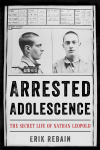Zusammenfassung
Nathan Leopold seemed to live a charmed life: a published, polyglot college graduate by the time he was 19 and from a prominent, wealthy Chicago family. So, it was a shock to everyone when he and his lover, Richard Loeb, confessed to killing their 14-year-old neighbor Bobby Franks “for a thrill.”
During the summer of 1924 the world watched in fascinated horror as the pair were defended by the famous Clarence Darrow in what many labeled "the trial of the century." There was a massive public outcry when the murderers were spared the death penalty, and once they were behind bars, most hoped they would never be heard from again.
33 years after the murder, it seemed that Nathan Leopold was a changed man. In prison he ran a high school and library, worked as a nurse, and helped find a cure for malaria. He was deemed rehabilitated and paroled to a tiny town in the mountains of Puerto Rico. There he got a degree in social work, raised funds to build a hospital, and advocated for the abolishment of prisons and capital punishment. When he died in 1971 there was an outpouring of support for the “gentle” “reformed” killer. Yet his life was not what it seemed.
100 years after the murder, this groundbreaking new biography uses previously unseen archival collections to look at the full life of Nathan Leopold and reveal the motivations behind Bobby’s death and the secrets kept hidden from history.
Schlagworte
History True Crime criminality American history LGBTQ Thrill kill Queer history Richard Loeb Leopold and Loeb Clarence Darrow Bobby Franks Bobby Franks murder Chicago history perfect crime crime of the century criminal behaviorKeywords
murder criminal psychology- Kapitel Ausklappen | EinklappenSeiten
- i–xii Preface i–xii
- 1–38 I CHILDHOOD 1–38
- 39–68 II CRIME 39–68
- 111–184 IV PRISON 111–184
- 185–262 V FREEDOM 185–262
- 263–266 CONCLUSION 263–266
- 267–270 ABBREVIATIONS 267–270
- 271–310 NOTES 271–310
- 311–318 BIBLIOGRAPHY 311–318
- 319–330 INDEX 319–330
- 331–332 ABOUT THE AUTHOR 331–332

